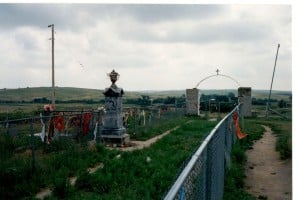An exhibition in Washington (state) that included art by a number of Native Americans, including Leonard Peltier, has provoked an outcry that may have Constitutional dimensions that went unconsidered. Peltier is a controversial Native American activist who was convicted of murdering in 1975 two FBI agents, Jack R. Coler and Ronald A. Williams. His conviction has long been a Rorschach Test for responses to Native American activism and the federal government’s response—Peltier has strenuously insisted he is innocent, and the FBI has adamantly maintained he was properly convicted. This has now raised its head in the realm of the public display of art, and whether the government may, or should discriminate among artists. After an outcry about the inclusion of Peltier’s art by a number of current and retired law enforcement officials, the Washington Department of Labor and Industries has announced that it will remove Peltier’s paintings from the display that marked Native American Indian Heritage Month there, and has apologized. Yet regardless of one’s opinion if Peltier’s guilt or innocence, the government has stepped in a First Amendment quagmire when it made a public forum available for expression and then removed the expressive work of only one person because of who he is. The First Amendment, after all, acts to protect expression regardless of popularity, indeed, particularly so. It is hard to argue that his work was removed for any of the reasons that courts generally permit restrictions on speech in the various kinds of public forums. It remains to be seen whether Peltier will object on those grounds.
Leonard Peltier and Public Displays of Art—The Government Taking Sides on Whose Paintings are Shown Stirs Up First Amendment Problems
Topics: Ray Lauer, Wounded Knee, Ronald A. Williams, North Dakota, Florida, South Dakota, American Indian Movement, Native American Indian Heritage Month, Pine Ridge Reservation, Native American, Coleman Federal Correctional Facility Coleman, National Retired Agents Association, Washington Department of Labor and Industries, First Amendment, Guardians of the Oglala Nation. GOON, Jack R. Coler, AIM, Leonard Peltier, Lakota Sioux Chippewa
Just Kidding? Celebrity Hacked Photograph Exhibition Scuttled
Having presumably gotten all of us to take the bait, appropriation artist XVALA has backed off and announced that he will not include versions of hacked photographs of Jennifer Lawrence, Kate Upton, and others, in a show entitled “No Delete.” The show will instead include, apparently, “the artist’s self-shot, life-size, nude images.” So, there’s that.
Topics: The Showroom, reddit, No Delete, Jennifer Lawrence, Florida, Jeff Hamilton, Kate Upton, Cory Allen Contemporary Art, photo hack, XVALA, Copyright, Fair Use, Warehouse Arts District
Can Copyright Aid Kate Upton, Jennifer Lawrence, and Other Victims of Celebrity Photo Hack?
As anyone with a computer now knows, the story broke last week of a supposed cache of hundreds of intimate photographs of numerous celebrities, including Kate Upton and Jennifer Lawrence, and Detroit Tigers pitcher Justin Verlander. Over the course of the week, rumors circulated about who, exactly, had them, and whether or where they would be leaked online. The story also raised important questions about privacy, security, and default cloud storage of which many people were simply unaware.
Topics: The Showroom, Richard Prince, U.S. Copyright Office, reddit, rights of publicity, Second Circuit, No Delete, Canal Zone, Jennifer Lawrence, Patrick Cariou, Florida, Detroit Tigers, Yes Rasta, Saint Petersburg, Jeff Hamilton, Kate Upton, Cory Allen Contemporary Art, selfie, photo hack, Justin Verlander, XVALA, Copyright, First Amendment, Fair Use, Warehouse Arts District, Art Law Report



